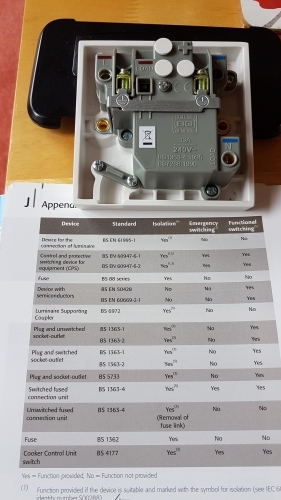Sparkingchip:
"
The product standard BS 7288 has changed in 2016, so the product we used to fit for the job is no longer suitable for that job. The product standard itself says so."
So further to that comment can you suggest what they can be used for?
Andy B.
mapj1:
Hmm. Now BS7671 is not a legal requirement, and there are plenty of situations were it is not applied, and installations can be perfectly safe. The DNO side of the wiring comes to mind as the most obvious that most folk will have come accross, but as one who has worked in both university and commercial R and D establishments, I can say that there are several situations where the RCD and for that matter the MCB/fusing requirements of the regs are simply inappropriate, and a properly engineered approach specific to the situation is needed. It is not sensible to demand that the regulations are modified to cover all possible cases.
If this was an industrial setting with a difficult load, I'd be well on the way to risk assessing the RCD out of circuit, or fitting an earth fault relay set to a high level, and using cables with earthed armour or braids, and perhaps additional bonding to cases of class 1 equipment, to give an equivalent protection. By this I mean that more than 2 credible and independent faults must occur to reach a dangerous state. In such a case, the paperwork is not quite the BS7671, but incudes the design authority calculations and description documents and risk assessment, that shows how the credible faults are safely mitigated.
This however is more the case of an enthusiastic amateur, and I agree this is trickier. First eliminate the possibility there is a real fault. Then confirm it is earth leakage that is causing the problem. Could the conduit take another set of cables, and split the load over two circuits ? This adds a slight risk if there is ever a very odd fault occurs between the two circuits, but should halve the stress on any one RCD.
You may decide to remove the RCD (or change it for one that is not providing protection at <30mA) but this needs a savvy customer who understands what the increase in risk actually means, and if you belong to a part P notification scheme that insists you must follow BS7671, then you may not be able to.
It is of course no more dangerous than any number of installations in current use, problems arise if there is a faulty load connected, and a person is connected between L and E, and the RCD should trip and it does not.
Sparkingchip:
Okay. I went and had a shower and stood there thinking about this (I know that is not a pretty image, but remember Archimedes had his eureka moment soaking in the bath.).
I can knock the idea that you cannot use a SCRD such as those made by BG as an isolator on the head.
Here is one I have fetched in from my van lying on top of table J1 in the IET Onsite Guide giving guidance on the selection of protective, isolation and switching devices, reproduced from BS7671.
The BG SCRD connection unit is complies with both BS7288:1990 and BS1363-4:1995
Although BS8277 does not approve it as an isolator BS1363-4 does.
If push comes to shove you can take the fuse out of it.
Andy Betteridge
NOTE 4 For SRCDs intended to provide isolation or fault protection, or to be used in IT systems, BS EN 61008-1 or BS EN 61009-1 should be used, as applicable, in conjunction with the requirements of BS 1363-2 for socket-outlets.
It's also worth noting that the 1990 version of BS 7288 had requirements for 3 mm isolation, the 2016 version of the standard does not.
Hence, as I said, guidance will need to change, and BS 7671:2018 is correct to not include BS 7288 in the list of acceptable RCDs.

gkenyon:
Sparkingchip:
Okay.
Here is the latest version of the Timeguard BS8277:2016 RCD connection unit
RCD Fused Connection Unit for additional protection against electric shocks and fire risk. The unit will remain latched if the power supply is tripped.
- Provides additional protection against the dangers of electrocution.
- Eliminates the need for plug-in residual current circuit breakers.
- Protects appliances from possible fire hazard.
- Extra fast action – trips out within 40 milliseconds (BS7288).
- Latching for continuous operation after supply interruption.
- Disconnects both Live and Neutral connections leaving Earth connection intact.
I am sure you can see what I am about to point out, that it states twice that the device provides additional protection.
I think it is acceptable to say that anyone other than an electrical engineer that would be additional protection as referred to be BS7671:2018.
Is it additional protection, but not as we know it?
Agreed that it's confusing information, but disconnection is not isolation, and still the Scope of BS 7288:2016 says what it says ...
I guess a question to the product manufacturer regarding what they are saying?
We're about to take you to the IET registration website. Don't worry though, you'll be sent straight back to the community after completing the registration.
Continue to the IET registration site